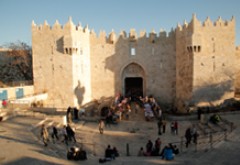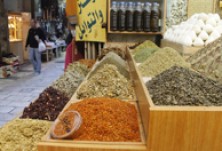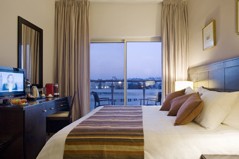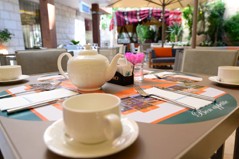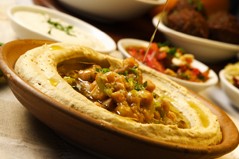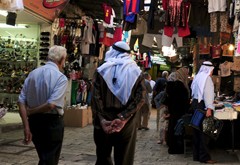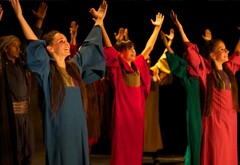The Islamic Museum makes up the southwest corner of al-Aqsa Mosque and is located a few meters west of al-Jami’ al-Aqsa. Reaching it is as easy as reaching the other sites on this trail. The museum is undergoing a process of renovation and reorganization of its exhibits; therefore, the visit might be limited, but the project is expected to be finished soon. The hours of visiting the museum those of visiting al-Aqsa Mosque. There is a fee that is usually included in the fee of visiting the Dome of the Rock and al-Jami’ al-Aqsa. Local student groups are generally exempt from paying this fee.
Specificity and Rarity of the Museum’s Collection
The Islamic Museum was established in 1922 AD by a decision of the Higher Islamic Council. As such, it is one of the first museums that were established in Jerusalem. The Islamic Museum is characterized by its artistic treasures that were offered as gifts to the museum or transferred from al-Aqsa Mosque and its buildings after the renovations. The majority of the museum’s contents are directly related to the heritage of al-Aqsa Mosque, Jerusalem, and Palestine, and, as such, they are rare. The valuable Qurans, for instance, were, until recently, placed in the hands of readers and scholars of the Mosque; the wooden fillings adorned the ceiling of the Mosque, and the mosaic tiles covered the walls of the Dome of the Rock.
The Museum Building
The historical museum building is composed of two main halls: the first was a Mamluk mosque for followers of the Malki doctrine, longitudinal and stretching from north to south at 54 x 9 meters. This hall was established by Sheikh Umar iIbn ‘Abd al-Nabi al-Maghribi al-Masmoudi in 1303 AD / 707 H, and its entrance was renovated in the late Ottoman era in 1871 AD / 1288 H. The second hall stretches from east to west at an area of 17 x 35 meters, and is part of a hall extending about 70 meters that was used as a mosque for women. It was built in the Fatimid era and renovated in the Franks era to serve their military purposes.
The Museum’s Collections
The Islamic Museum holds rare types of Islamic art covering a period of nearly 10 centuries. There are artifacts from various parts of the Islamic world, including North Africa, Egypt, Syria, Turkey, Iran, and East Asia. There is also a set of Umayyad woods and the remnants of the Nour al-Din pulpit that was burned in 1969 AD, in addition to a treasure of rare Mamluk documents unparalleled in other museums. This is in addition to metal pieces, marble and tiles, as well as foundations inscription panels in various Arabic calligraphy such as kufi, naskhi and thulth scribt.
The Qurans
The Museum is home to a rare set of Holy Qurans that were glamorously inscribed and bonded, dating back to various Islamic periods. They were written using the different kufi, maghribi, naskhi,thulth, and persian calligraphy. Most of them were outstanding works of art given as gifts to al-Aqsa Mosque and the Dome of the Rock, and placed as religious endowments for the use of specialized readers, most prominent of which are the ones from the Moroccan King, Sultan Suleiman al-qQanuni, Ottoman Sultan Bayazid, the huge and ornate Quran from the Mamluk Sultan Barsbay, and the kufi Quran attributed to al-Hassan ibn al-Hussein ibn Ali ibn Abi Taleb which dated to the 3rd century of Hijra (9th century AD).
Wooden Panels
The Museum is home to nearly 300 wooden artifacts dating back to various Islamic periods, the most prominent of which are the wooden panels that used to cover the ceiling of the middle porch of al-Jami’ al-Aqsa and were removed during renovations in 1040. These panels were decorated with deeply carved geometric and plant motifs. There are also Fatimid wooden pieces with kufi calligraphy, in addition to a set of links and columns that were supporting the Dome of the Rock and the porticoes of al-Jami’ al-Aqsa, as well as the Ottoman decorations that decorated the wooden ceiling of the Dome of the Rock. There are some pieces from the pulpit of Nour al-Din Mahmoud ibn ‘Imad al-Din Zinki, which is known as a rare and valuable piece made of cedar wood and adorned with ivory and mother of pearl, and void of any use of glue or nails. It was manufactured by order of Nour al-Din in Aleppo 20 years before the liberation of Jerusalem. It was also burned when al-Jami’ al-Aqsa suffered from arson by Michael Denis Rohan on 21st August 1969.
The Treasure of Mamluk Documents
The Islamic Museum’s collections include a set of documents dating back to the early 14th century in the Mamluk period. There are nearly 1,000 documents in good condition. The majority of them were written in Arabic and about 30 documents were written in Persian. The documents present the social history of the residents of Jerusalem in terms of marriage, divorce, inheritance, trading, stories, and petitions, as well as official orders by the sultan. These documents are particularly important because the information they contain is not stated in any books on history. They are mirrors that reflect the daily conditions of people in the Mamluk era.
The Museum’s Marble Pieces
The Islamic Museum hosts a set of marble and stone panels dating back to various time periods and written in different styles of calligraphy as tombstones and plaques for buildings. Most of them come from Jerusalem, but some were brought from other Palestinian cities. There is also a large collection of capitales that were carved with plant motifs. These decorations followed the general approach of Islamic art that tended to avoid images of human beings and animals in religious places. The capitales were used for the columns that carried the lintels and porticoes inside the buildings of the area of Al-Aqsa Mosque, particularly the mosque itself, and they are the remains of renovations of the eastern hallway that were done in the 1940s.
Tankiz’ Glass Lantern
The Islamic Museum’s collection includes a modest set of glass artifacts dating back to the Byzantine and Islamic periods. These are mainly various types of jars, including tear-holding jars, lanterns, kohl jars, and plates. The museum has a colored glass lantern that is considered one of its most important glass artifacts. It was painted by Amir Tankiz, curator of the Kingdoms of Bilad al-Sham in 1328 AD (729 H). There is also Quranic writing in blue in the Mamluk thulth calligraphy on a golden background, decorated with a plant motif with white veins and green and red leaves. The text reads: ‘Allah’s mosques are built by those who believe in Allah and Judgment Day.’ The writing includes three circles, inside of each is a cup painted in gold on a red base. The cup was the blazon of Tankiz and is proof that he undertook the position of the Sultan’s drink taster.
The Tiles Collection
One of the richest and most important collections in the Islamic Museum is the ceramic tiles, most of which are in storage and only a few samples of which are on display in the museum, including the tiles that show the Yassin Surah (verse) of the Holy Quran. The majority of the tiles were taken from the exterior walls of the Dome of the Rock during the 1964 renovations. Interestingly, the names of some of the most proficient manufacturers were written on these tiles, including the work of al-Haj Ni’mat Allah Khuqandi (1233 H) and there is no God but Allah, it is edited by the weak slave Muhmmad Darwish in 1233 H . There is also a collection of large pottery pieces that were used to store liquids, like water and oil, as well as a collection of oil lamps and some pottery plates and cups.
Metal Artifacts
There is also a valuable collection of metal artifacts in the Islamic Museum. Some were made from steel, others from copper adorned with silver and gold. This includes the iron fence that surrounded the Rock during the Franks era, which was placed to prevent intruders and pilgrims from chopping small pieces of the Rock as souvenirs. The fence shows proficient handiwork, most likely done in one of the cities in the south of France. Additionally, there is a set of candlesticks and incense burners, the most prominent of which is the candlestick of Nasir al-Din qutb al Islam wal Muslimin Urtuq Arslan ibn Ayl Ghazi, and an incense burner that was a gift from Sultan Abu Sa’id Barqouq to al-Haram al-Ibrahimi (The Ibrahimi Sanctuary) in Hebron. There is also a set of large cooking pots that were in the Takiyya (soup kitchen) of Khasuki Sultan, measuring 135 cm in diameter and 84 cm high. The cooking pots have a set of utensils that are each one meter long. Additionally, there are various other textile pieces, some from the cover of the Ka’bah, as well as pieces of weapons and Islamic coins.

